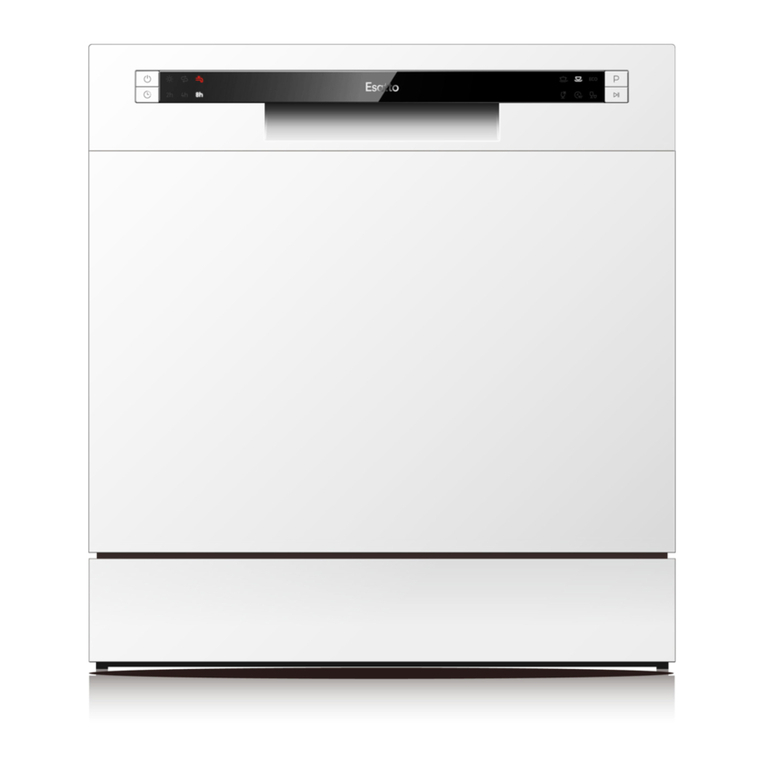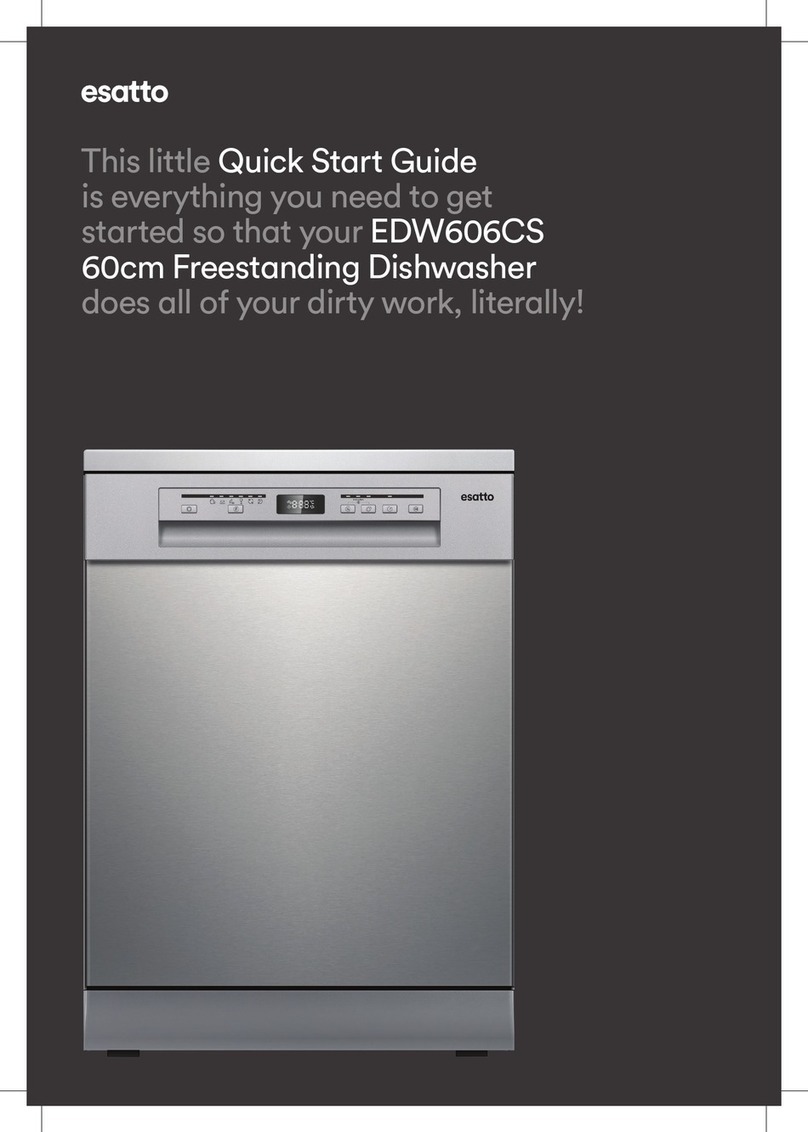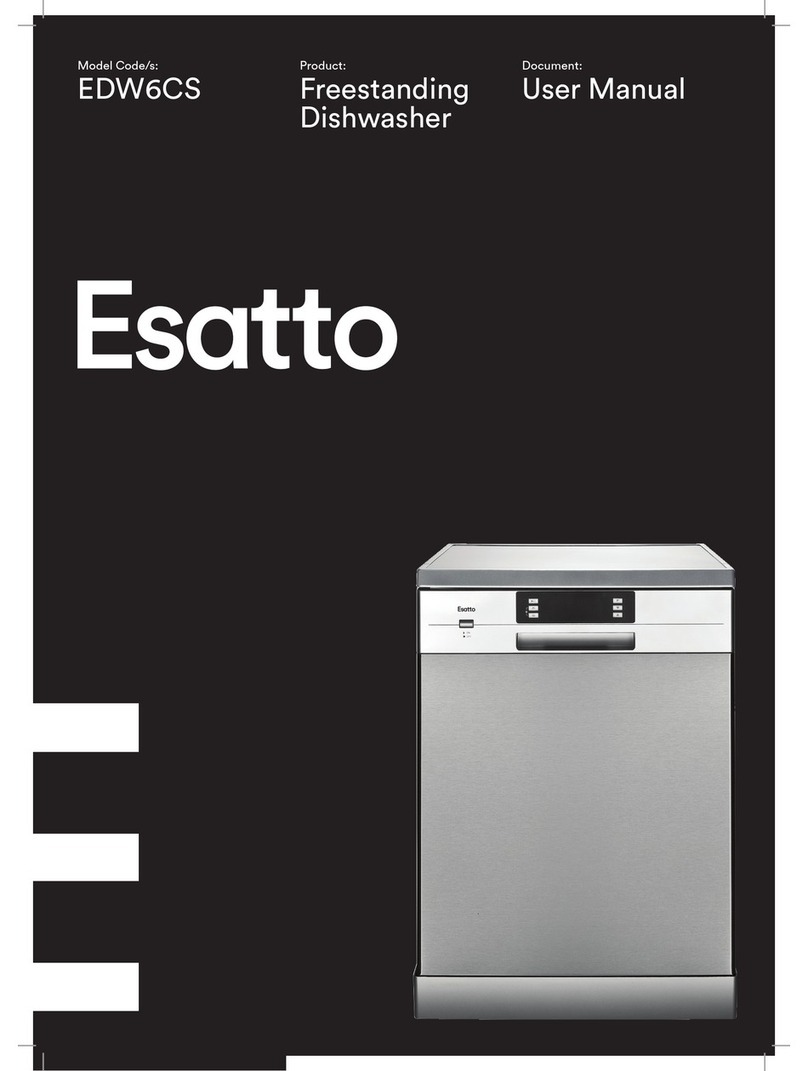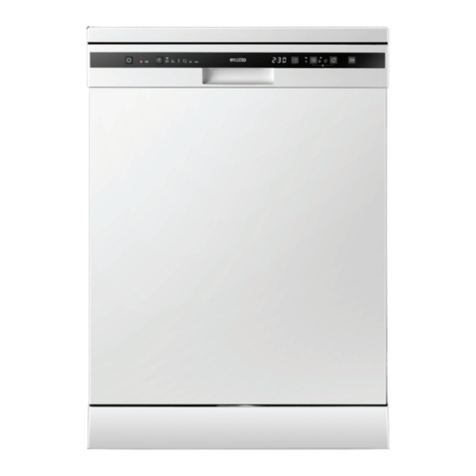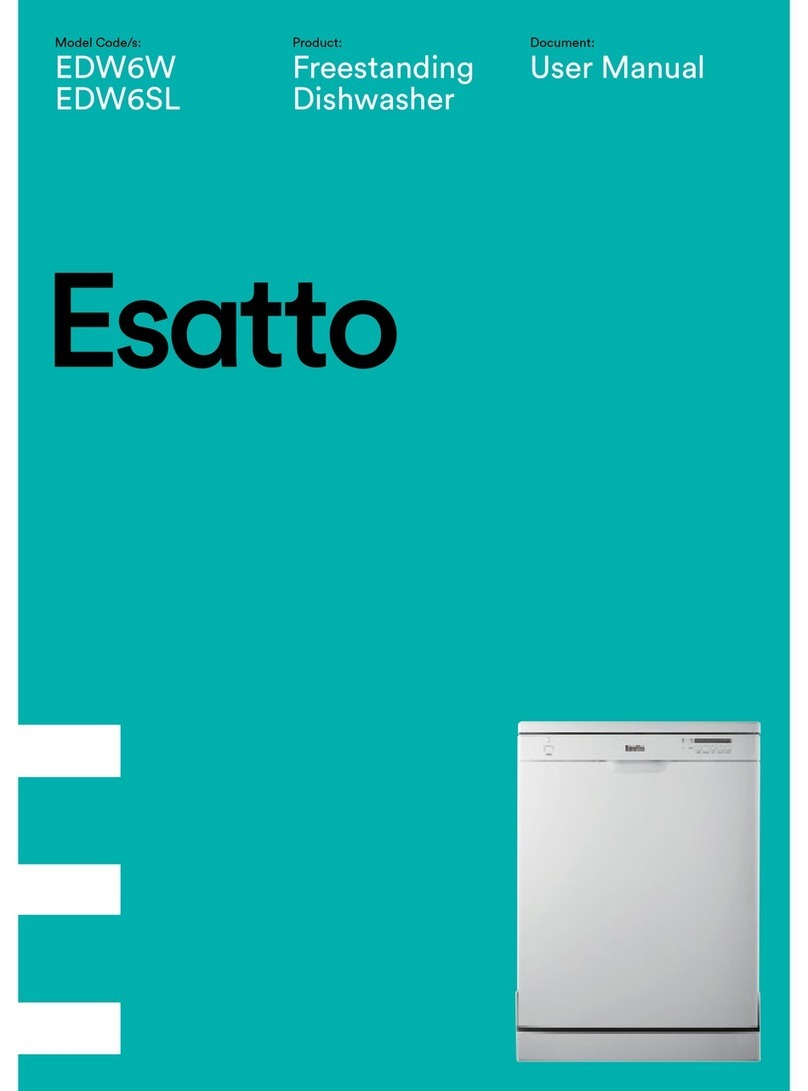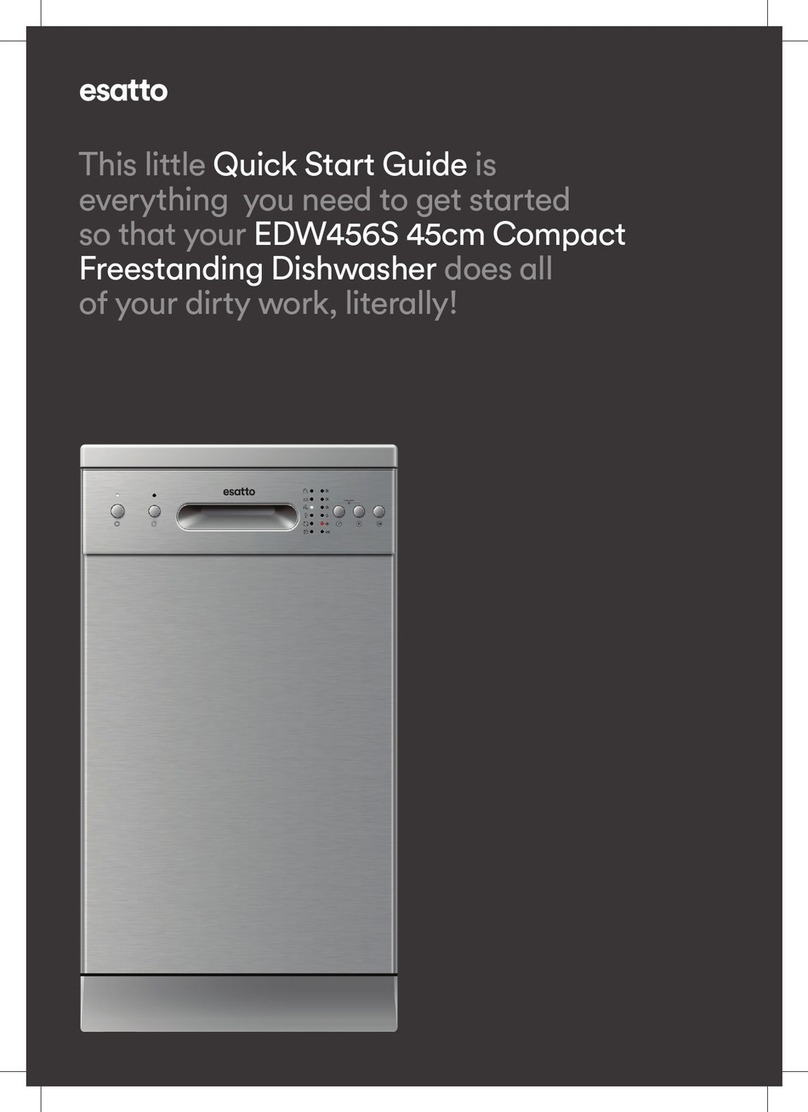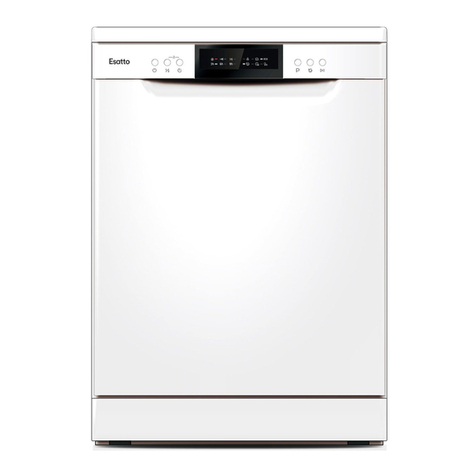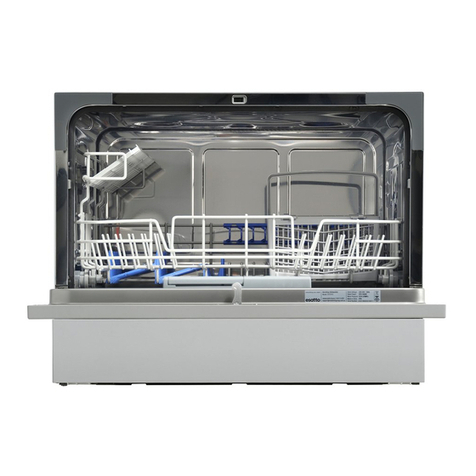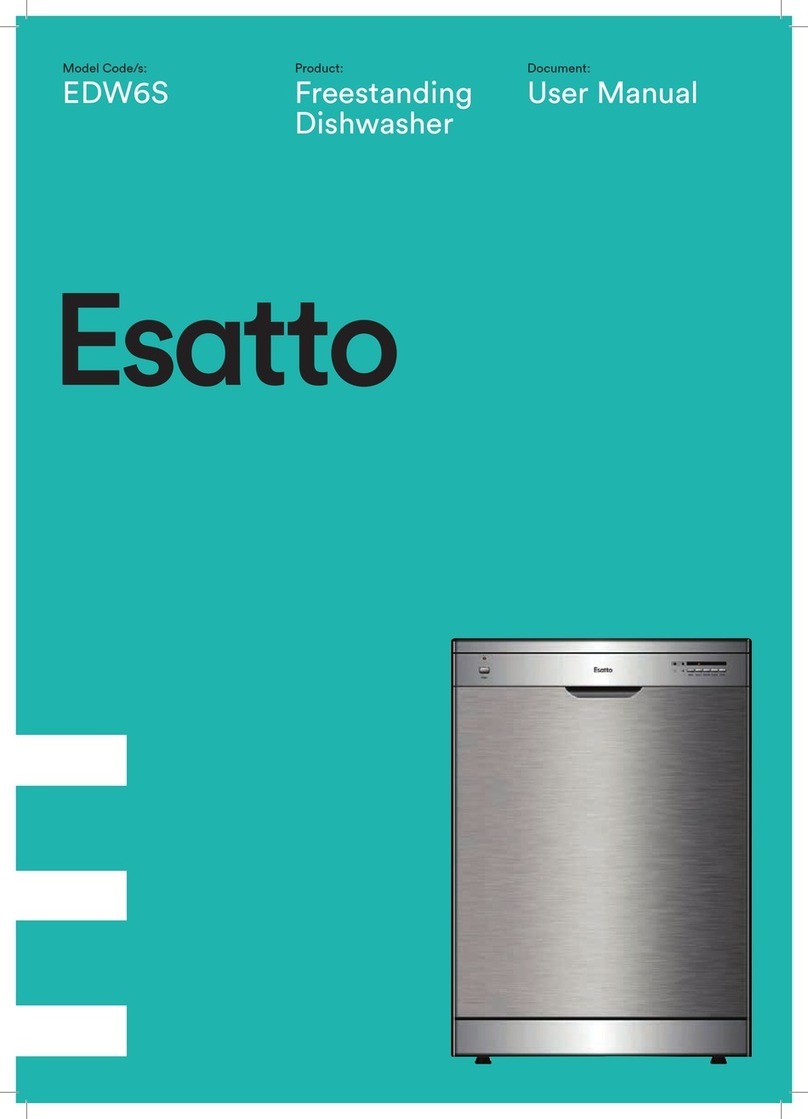
10
• Consider buying utensils which are identied as
dishwasher-proof.
• For particular items, select a program with the
lowest possible temperature.
• To prevent damage, do not take glass and cutlery
out of the dishwasher immediately after the
program has ended.
CUTLERY/DISHES SUITABILITY
The following are not suitable
• Cutlery with wooden, horn china
or mother-of-pearl handles
• Plastic items that are not heat resistant
• Older cutlery with glued parts
that are not temperature resistant
• Bonded cutlery items or dishes
• Pewter or cooper items
• Crystal glass
• Steel items subject to rusting
• Wooden platters
• Items made from synthetic bers
The following are of limited suitability
• Some types of glasses can become dull
after a large number of washes
• Silver and aluminum parts have a tendency
to discolour during washing
• Glazed patterns may fade if machine
washed frequently
RECOMMENDATIONS FOR LOADING
THE DISHWASHER
Scrape o any large amounts of leftover food. Soften
remnants of burnt food in pans. It is not necessary to
rinse the dishes under running water.
For best performance of the dishwasher, follow these
loading guidelines.
• Items such as cups, glasses, pots/pans, etc. are
faced downwards.
• Curved items, or ones with recesses, should be
loaded aslant so that water can run o.
• All utensils are stacked securely and can not tip
over.
• All utensils are placed in the way that the spray
arms can rotate freely during washing.
• Load hollow items such as cups, glasses, pans
etc. With the opening facing downwards so that
water cannot collect in the container or a deep
base.
• Dishes and items of cutlery must not lie inside one
another, or cover each other.
• To avoid damage, glasses should not touch
one another.
• The upper basket is designed to hold more
delicate and lighter dishware such as glasses,
coee and tea cups.
• Long bladed knives stored in an upright position
are a potential hazard!
• Long and / or sharp items of cutlery such as
carving knives must be positioned horizontally
in the upper basket.
• Please do not overload your dishwasher.
This is important for good results and for
reasonable consumption of energy.
NOTE: Very small items should not be washed in the
dishwasher as they could easily fall out of the basket.
Removing the dishes
To prevent water dripping from the upper basket into
the lower basket, we recommend that you empty the
lower basket rst, followed by the upper basket.
WARNING
Items will be hot! To prevent damage, do not take
glass and cutlery out of the dishwasher for around
15 minutes after the program has ended.
Loading the upper basket
The upper basket is designed to hold more
delicate and
lighter dishware such as glasses, coee and tea cups
and saucers, as well as plates, small bowls and
shallow
pans (as long as they are not too dirty). Position the
dishes and cookware so that
they will not get moved by the
spray of water.
Loading the lower basket
We suggest that you place large items and the most
dicult to clean items are to be placed into the lower
basket: such as pots, pans, lids, serving dishes and
bowls, as shown in the gure below. It is preferable to
place serving dishes and lids on the side of the racks
in order to avoid blocking the rotation of the top spray
arm.
The maximum diameter advised
for plates in front of the detergent
dispenser is of 19 cm, this not to
hamper the opening of it.
Loading the cutlery basket
Cutlery should be placed in the cutlery rack separately
from each other in the appropriate positions, and do
make sure the utensils do not nest together, this may
cause bad performance.
WARNING
Do not let any item extend through the
bottom. Always load sharp utensils with the
sharp end downwards!
NOTE:
For the best washing eect, please load the baskets
referred in the Loading Recommendations section.
Loading the upper basket
The upper basket is designed to hold more delicate and
lighter dishware such as glasses, coffee and tea cups
and saucers, as well as plates, small bowls and shallow
pans (as long as they are not too dirty). Position the
dishes and cookware so that they will not get moved by
the spray of water.
WARNING
Do not let any item extend through
the bottom.
Always load sharp utensils with the
sharp point down!
Loading the cutlery basket
Cutlery should be placed in the cutlery rack separately from each other in the
appropriate positions, and do make sure the utensils do not nest together, this may
cause bad performance.
8
For the best washing effect, please load the baskets refer to standard
loading options on last section of PART Generic VersionⅠ:
For the best washing effect, please load the baskets refer to standard
loading options on last section of PART Ⅰ: Generic Version
Loading the lower basket
We suggest that you place large items and the most
difficult to clean items are to be placed into the lower
basket: such as pots, pans, lids, serving dishes and bowls,
as shown in the figure below. It is preferable to place
serving dishes and lids on the side of the racks in order to
avoid blocking the rotation of the top spray arm.
The maximum diameter advised for plates in front of the
detergent dispenser is of 19 cm, this not to hamper the
opening of it.
Loading the upper basket
The upper basket is designed to hold more delicate and
lighter dishware such as glasses, coffee and tea cups
and saucers, as well as plates, small bowls and shallow
pans (as long as they are not too dirty). Position the
dishes and cookware so that they will not get moved by
the spray of water.
WARNING
Do not let any item extend through
the bottom.
Always load sharp utensils with the
sharp point down!
Loading the cutlery basket
Cutlery should be placed in the cutlery rack separately from each other in the
appropriate positions, and do make sure the utensils do not nest together, this may
cause bad performance.
8
For the best washing effect, please load the baskets refer to standard
loading options on last section of PART Generic VersionⅠ:
For the best washing effect, please load the baskets refer to standard
loading options on last section of PART Ⅰ: Generic Version
Loading the lower basket
We suggest that you place large items and the most
difficult to clean items are to be placed into the lower
basket: such as pots, pans, lids, serving dishes and bowls,
as shown in the figure below. It is preferable to place
serving dishes and lids on the side of the racks in order to
avoid blocking the rotation of the top spray arm.
The maximum diameter advised for plates in front of the
detergent dispenser is of 19 cm, this not to hamper the
opening of it.
7
Load hollow items such as cups, glasses, pans etc. With the opening facing
downwards so that water cannot collect in the container or a deep base.
Dishes and items of cutlery must not lie inside one another, or cover each other.
To avoid damage, glasses should not touch one another.
The upper basket is designed to hold more delicate and lighter dishware such as
glasses, coffee and tea cups.
Long bladed knives stored in an upright position are a potential hazard!
Long and / or sharp items of cutlery such as carving knives must be positioned
horizontally in the upper basket.
Please do not overload your dishwasher. This is important for good results and for
reasonable consumption of energy.
NOTE:
Very small items should not be washed in the dishwasher as they could easily fall
out of the basket.
To prevent water dripping from the upper basket into the lower basket, we
recommend that you empty the lower basket first, followed by the upper basket.
Removing the dishes
WARNING
Items will be hot! To prevent damage, do not take glass and
cutlery out of the dishwasher for around 15 minutes after the
program has ended.
Loading the upper basket
The upper basket is designed to hold more delicate and
lighter dishware such as glasses, coffee and tea cups
and saucers, as well as plates, small bowls and shallow
pans (as long as they are not too dirty). Position the
dishes and cookware so that they will not get moved by
the spray of water.
WARNING
Do not let any item extend through
the bottom.
Always load sharp utensils with the
sharp point down!
Loading the cutlery basket
Cutlery should be placed in the cutlery rack separately from each other in the
appropriate positions, and do make sure the utensils do not nest together, this may
cause bad performance.
8
For the best washing effect, please load the baskets refer to standard
loading options on last section of PART Generic VersionⅠ:
For the best washing effect, please load the baskets refer to standard
loading options on last section of PART Ⅰ: Generic Version
Loading the lower basket
We suggest that you place large items and the most
difficult to clean items are to be placed into the lower
basket: such as pots, pans, lids, serving dishes and bowls,
as shown in the figure below. It is preferable to place
serving dishes and lids on the side of the racks in order to
avoid blocking the rotation of the top spray arm.
The maximum diameter advised for plates in front of the
detergent dispenser is of 19 cm, this not to hamper the
opening of it.
Prepring Loding Dishes
19
1.Upper basket:
2.Lower basket:
1
2
3
Cups
Saucers
Glasses
Item
Number
4
5
6
7
Dinner plates
Soup plates
Dessert dishes
Cutlery basket
Item
Number
11
11
11
1111
1111
22
22
33
33
66
66
66
66
77
5544
Loading The Baskets According To AS/NZS 2007.1
19
1.Upper basket:
2.Lower basket:
1
2
3
Cups
Saucers
Glasses
Item
Number
4
5
6
7
Dinner plates
Soup plates
Dessert dishes
Cutlery basket
Item
Number
11
11
11
1111
1111
22
22
33
33
66
66
66
66
77
5544
Loading The Baskets According To AS/NZS 2007.1
20
3.Cutlery basket:
2
2
2
2 2 2 2
1
1 3
3
5
5
5
5
5
5
3
3
3
3
3
3
3
3
3
31
11
2
2
2
44 4 4 4 4
44
2 2
1
1 1
1
1 1 5
5
4 4 4 4
2 51 4443
1
2
3
4
5
Forks
Soup spoons
Dessert spoons
Teaspoons
Knives
Item
Number
Information for comparability tests in accordance with (*AS/NZS 2007.1 )
Capacity: 12 place settings
Position of the upper basket: lower position
Program: ECO
Rinse aid setting: 6
Detergent(Pre/main): 5/25g
Door is open at the end of the drying cycle for the drying performance test
and last 40mins.
(Door position: Open 50 mm)
15 5 5 5
